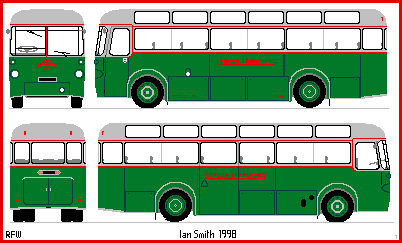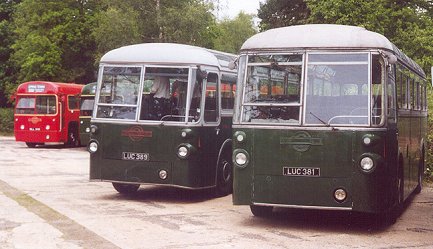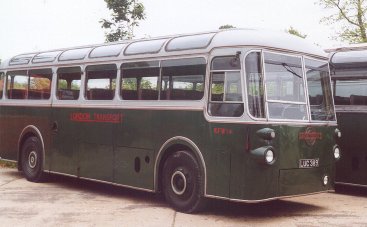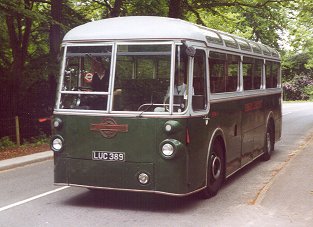
The Private Hire RFWs, 3RF3
RFW 1 - RFW 15, Total 15
This page created 14th January 1998, updated 7th February 2002, by Ian Smith..

The RFWs were very different from the other Regal Fours.
They were 8ft wide, instead of 7ft 6in, and their Eastern Coach Works
bodies were of a totally different style. They were built as coaches,
to try to improve on London Transport's Private Hire fleet, which had
tended to operate better quality buses rather than luxury coaches.
The Private Hire Fleet was in a poor state anyway, comprising a single Private
Hire TF
and the slow, old-fashioned six-wheeler LTCs.
With the Festival of Britain due to show Britain's post-war best to the world,
the London Transport coach fleet was an embarassment.
The order was placed in parallel with that for the Private Hire RFs.
Eastern Coach works was chosen as a bodybuilder to comply with the
notion that as a nationally owned operator it should where possible
buy its bodies from the nationally owned bus body builder! (LT avoided
this with the RTs and RFs because ECW could not handle the volume required).
 Apart from their greater width, the RFWs differed very much in their styling
from the Metro-Cammell RFs. The front had a pair of windscreens made up of
a series of flat panes, seven in all, giving the impression of a curved windcreen.
Below them the sidelights and headlights were housed in fairings in the curve of the wings,
a design-ploy to suggest speed.
The main windows were arranged in pairs, with just a narrow aluminium strip
between. They were all full-drop windows. The offside had an emergency door,
so the back did not have to include one.
The rear view was to become much better known on the Bristol coaches,
with its corner windows and central window arrangement.
For signalling, the RFW had semaphore arms fitted in the front corners,
and illuminating arrows each side of the translucent rear number plate.
Livery was very similar to the Private Hire RFs,
with the main colours flake grey and Lincoln green, with narrow red trim lines
and aluminium edging. The LT emblem on the front, and the fleetname, were in red.
The unloaded weight was 8ton 8cwt, compared to the 7t 10cwt of the RF (and RT).
Apart from their greater width, the RFWs differed very much in their styling
from the Metro-Cammell RFs. The front had a pair of windscreens made up of
a series of flat panes, seven in all, giving the impression of a curved windcreen.
Below them the sidelights and headlights were housed in fairings in the curve of the wings,
a design-ploy to suggest speed.
The main windows were arranged in pairs, with just a narrow aluminium strip
between. They were all full-drop windows. The offside had an emergency door,
so the back did not have to include one.
The rear view was to become much better known on the Bristol coaches,
with its corner windows and central window arrangement.
For signalling, the RFW had semaphore arms fitted in the front corners,
and illuminating arrows each side of the translucent rear number plate.
Livery was very similar to the Private Hire RFs,
with the main colours flake grey and Lincoln green, with narrow red trim lines
and aluminium edging. The LT emblem on the front, and the fleetname, were in red.
The unloaded weight was 8ton 8cwt, compared to the 7t 10cwt of the RF (and RT).
They were delivered just in time for the Festival, the first arriving in
April 1951, and the last before the end of May.
They were allocated to garages all round the LT system ,
both Central and Country.
 London Transport was restricted by statute in its radius of operation,
so its private Hire fleet could not compete well with the many private
coach firms around the capital. Whereas they could mix long-distance hires
with short fillers, LT was committed to just the short jobs and contract work
for which the RFWs were not ideal.
London Transport was restricted by statute in its radius of operation,
so its private Hire fleet could not compete well with the many private
coach firms around the capital. Whereas they could mix long-distance hires
with short fillers, LT was committed to just the short jobs and contract work
for which the RFWs were not ideal.
RFW 6 and 14 met again for the first time uin years, at the RF50 celebrations ay Cobham Bus Museum.
Photo, used by Ian Smith.
By the early sixties, with the ordinary stage carriage services short of staff,
finding overtime staff to operate the private hires was becoming
increasingly more difficult to justify. London Transport started to tender
out all its contract, sightseeing and private tour work,
and the writing was on the wall for the dedicated Private Hire fleet.
Summer 1963 was the last for the RFWs as a whole, just four being licensed
by Country Area for the 1964 summer season (1, 6, 11, 14).
All fifteen were sold, ten of them to Ceylon,
where some were still operating in the early 80's.
One was sold for continued PSV service in England (Elm Park Coaches, Hornchurch),
two were used by St Thomas' Hospital, and the other two found non-PSV uses.
Two of them, 6 and 14, survived into preservation in the UK.


RFW14 made an appearance at the RF50 celebrations at Cobham in June 2001.

 coach histories coach histories
 photographic references photographic references

 Bus Stop Bus Stop
 Contents Contents
 Private Hires Private Hires
 RFWs RFWs
 Greenlines Greenlines
|

 Apart from their greater width, the RFWs differed very much in their styling
from the Metro-Cammell RFs. The front had a pair of windscreens made up of
a series of flat panes, seven in all, giving the impression of a curved windcreen.
Below them the sidelights and headlights were housed in fairings in the curve of the wings,
a design-ploy to suggest speed.
The main windows were arranged in pairs, with just a narrow aluminium strip
between. They were all full-drop windows. The offside had an emergency door,
so the back did not have to include one.
The rear view was to become much better known on the Bristol coaches,
with its corner windows and central window arrangement.
For signalling, the RFW had semaphore arms fitted in the front corners,
and illuminating arrows each side of the translucent rear number plate.
Livery was very similar to the
Apart from their greater width, the RFWs differed very much in their styling
from the Metro-Cammell RFs. The front had a pair of windscreens made up of
a series of flat panes, seven in all, giving the impression of a curved windcreen.
Below them the sidelights and headlights were housed in fairings in the curve of the wings,
a design-ploy to suggest speed.
The main windows were arranged in pairs, with just a narrow aluminium strip
between. They were all full-drop windows. The offside had an emergency door,
so the back did not have to include one.
The rear view was to become much better known on the Bristol coaches,
with its corner windows and central window arrangement.
For signalling, the RFW had semaphore arms fitted in the front corners,
and illuminating arrows each side of the translucent rear number plate.
Livery was very similar to the 


 coach histories
coach histories Bus Stop
Bus Stop Contents
Contents Private Hires
Private Hires RFWs
RFWs